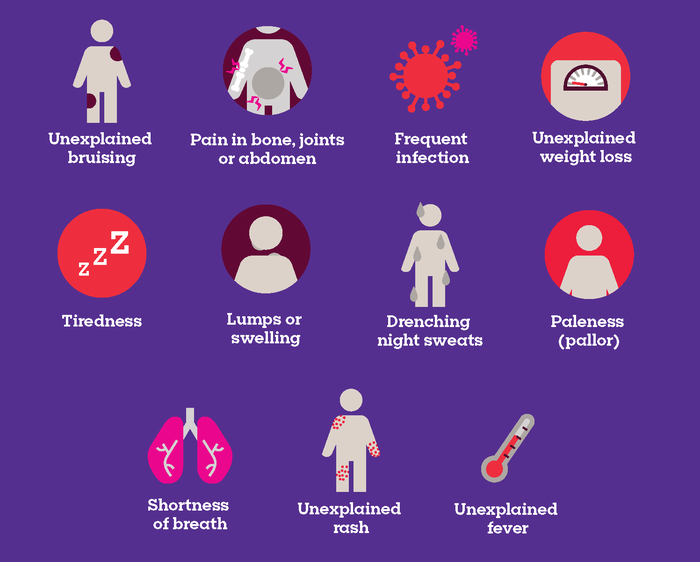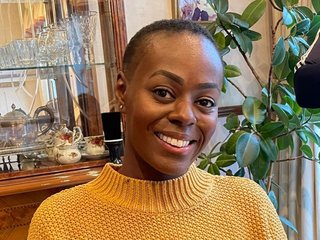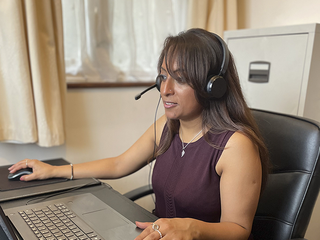Blood cancer symptoms and signs
Blood cancer symptoms vary depending on the type of blood cancer, whether it's leukaemia, lymphoma, myeloma, MDS, MPN or any other blood cancer. Learn about the common symptoms, and what to do if you're worried.
Blood cancer symptoms
The most common symptoms of blood cancer include:
- Unexplained bruising or bleeding
- Unexplained pain or aching in your bones or joints that interferes with your sleep or daily activities
- Unexplained pain, discomfort or feeling full (bloated) in your stomach area
- Frequent, persistent or severe infections
- Unexplained fever or a high temperature
- Unexplained weight loss
- Tiredness that doesn’t improve with rest or sleep
- Lumps or swelling anywhere on your body
- Drenching night sweats
- Paleness (pallor)
- Shortness of breath
- An unexplained rash or itchy skin anywhere on your body that doesn’t improve with treatment.
It’s important to know that not everyone will have the same symptoms, and some people may have symptoms that are not listed on this page.
There is a diagram showing the symptoms of blood cancer below, as well as a video with Senior Support Services Nurse Gemma who explains the common symptoms of blood cancer in more detail.
If you’d like to see more information about what may be causing each symptom, scroll down to the section at the bottom of this page called ‘Causes of blood cancer symptoms’.

Common symptoms of blood cancer
Urgent symptoms to look out for
Some types of blood cancer, for example acute myeloid leukaemia (AML), develop very quickly and can suddenly make you very unwell. This is known as leukostasis or blast crisis.
Symptoms of leukostasis or blast crisis are caused by a very high level of white blood cells, and may include:
- breathing problems
- neurological symptoms like visual changes or confusion
- vomiting
- loss of muscle control
- seizures.
These symptoms are urgent and require immediate medical attention. Call 999 or go to A&E if you notice any of these symptoms in yourself or someone you know.
Symptoms on different skin tones
Although symptoms of blood cancer are usually the same for people of all ethnicities, some symptoms may show up differently on darker skin tones. For example:
- Bruises generally start as red, purple or brown patches which may change colour and get darker over time. They often feel tender. On Black and brown skin, bruises may be difficult to see initially, but as they develop, they show up as darker than the skin around them.
- Rashes often appear as clusters of tiny spots (petechiae) or larger blotches (purpura). On Black and brown skin, they may look purple or darker than the surrounding skin. If you press on them, petechiae and purpura don’t fade.
- Paleness (pallor) may be more noticeable in your lips, gums, palms of your hands or nail beds if you have Black or brown skin. In all skin tones, pallor can be checked by pulling down the lower eyelid. The inside is normally dark pink or red, but if it’s pale pink or white, it’s a sign of pallor.
You can read more about experiences of blood cancer for people of Black, African Caribbean or mixed heritage on our Black with blood cancer page.

Information for the Black community
Get essential information about blood cancer including stories from Black people with blood cancer and where to find support.
What to do if you have symptoms of blood cancer
If you have any symptoms of blood cancer, or any unexplained symptoms that you’re worried about, book an appointment with your GP or call NHS 111. It’s a good idea to make a note of exactly what your symptoms are, how long you’ve had them, and if anything has changed or got worse recently. You might like to order our free blood cancer symptoms guide, which you can fill in and take to your appointment.
You should be given a blood test, which may happen at your GP practice, but you might have to go to a nearby hospital or clinic if your GP can’t do the test themselves.
When your results are ready, your GP will contact you and explain what they mean.
Having any of the symptoms mentioned on this page doesn’t necessarily mean that you have blood cancer – many people won’t. But, it's still important to find out what’s causing the symptoms. You may need to have more tests if your results are unclear.
Even if you have just one symptom that you can't explain, book the appointment with your GP. And, if you suddenly feel very unwell at any time, get medical help straight away by calling 999 or going to A&E.
If you want to talk to someone about your worries, contact our Support Service to speak to one of our nurses. They will listen to your concerns, explain what to expect from a GP visit and talk you through your next steps.
Questions to ask your doctor
Here are some things you might want to ask your GP or any other doctors if you go and get your symptoms checked out:
- Could this be blood cancer?
- Do I need a blood test? What will it look for?
- Do I need to have any other tests?
- Will I need any scans?
- Do you need me to give a urine sample?
- Can I be referred for further tests on a fast track or urgent pathway?
- How long will it take to get my results back?
- How will I get my results (phone, email, NHS App, in person) and what will happen next?
Don’t be afraid to request a second opinion or ask to see a different doctor if you feel like you aren’t being listened to or taken seriously.
The Faster Diagnosis Pathway
If your GP says you might have to wait a long time before you have a blood test or see a specialist, you can say “As my symptoms might be blood cancer, can I be referred for tests on the Faster Diagnosis Pathway?”
The Faster Diagnosis Pathway aims to diagnose or rule out cancer within 28 days. This may sound alarming, but keep in mind that most people won't have cancer. For the few people who do have cancer, getting diagnosed earlier can mean treatment is easier and more successful.
If your GP says they don’t think you have blood cancer, and your symptoms don’t go away or get worse, don’t be afraid to go back and see them. You should book another appointment even if you are told you have a different diagnosis.
Jess's Rule
If you end up seeing your GP three or more times with the same symptoms, and any treatment they recommend isn’t working, you can ask them to follow Jess’s Rule. This is a safety initiative in the NHS that is aimed at improving early detection rates of serious illnesses.
Asking about Jess’s Rule should encourage your doctor to reconsider their first diagnosis, or do more tests if they’re unsure about what is causing your symptoms.
Free blood cancer symptoms guide
Our free blood cancer symptoms guide is a pocket-sized reminder of these symptoms and provides space for you to record any that you might experience. If you need to get checked out, it also includes things to think about before your appointment and questions to ask your doctor.
Causes of blood cancer symptoms
In this section, we explain a bit more about why common symptoms of blood cancer may happen.
- Unexplained bruising or bleeding
Bruises and bleeding can be caused by a low level of platelets, which help the blood to clot.
Bruises are a sign of bleeding under the skin and normally happen after an injury, but if they appear for no reason, they can be a sign of low platelets. They usually show as a different colour to the skin around them, and may feel tender when you touch them.
You may see small spots in the skin (petechiae) or larger discoloured patches (purpura). These may look like a rash but are actually clusters of small bruises. On black and brown skin petechiae and purpura typically look purple or darker than the surrounding skin, and on lighter skin they tend to show as red or purple.
You may also have bleeding from your nose or gums, prolonged bleeding from a cut, heavy periods, or blood in your urine or poo. In very rare cases, there may be a bleed into the brain, which can cause neurological symptoms.
- Unexplained pain or aching in your bones or joints
Many people will experience achy or painful bones or joints for a variety of reasons, but if the aching or pain is unusual for you or unexplained by injuries or any other condition, or if it gets progressively worse, speak to your doctor.
Some blood cancers, such as myeloma or acute lymphoblastic leukaemia (ALL), are more likely than others to cause bone or joint pain in your back, ribs, hips, arms or legs.
- Pain, discomfort or feeling full (bloated) in your stomach area
Abdominal (stomach) pain can be caused by abnormal blood cells building up in your spleen.
You may feel full after only eating small amounts, have discomfort under your ribs on the left side, notice bloating or swelling, or occasionally feel unexplained pain.
- Infections and unexplained fever
Fever and infections can be caused by a low level of white blood cells, which fight infection.
You may experience severe or repeated infections or have a high temperature, even if there aren’t any other obvious signs of infection. Infections can cause flu-like symptoms like chills or shivering, coughing or a sore throat.
- Unexplained weight loss
Your body’s reaction to cancer cells can alter your metabolism and may cause you to lose weight. This is because the cancer cells use energy from your food, leaving less for your normal cells.
You may also lose your appetite or feel less hungry, meaning you end up eating less than normal.
- Tiredness that doesn’t go away with sleep or rest
Feeling tired can be normal, but extreme tiredness that doesn’t go away after sleep or rest is also called fatigue. Fatigue is a common symptom of blood cancer, and can affect you mentally as well as physically.
- Lumps or swellings
These symptoms can be caused by abnormal white blood cells building up in your lymph glands.
You’re most likely to notice lumps or swellings in your neck, armpit or groin. They’re usually painless, although some people experience aching.
If there are lumps or swellings further inside your body, they can press on organs such as your lungs or stomach, and this can cause pain, discomfort, coughing or breathlessness. You may not always be able to see a lump or swelling, especially if it is below your skin, so tell a doctor if any parts of your body feel sore, tender or bloated.
- Drenching night sweats
Some people with lymphoma have drenching night sweats, but we don’t know yet what causes this.
- Paleness (pallor)
Paleness (pallor) is caused by a low level of red blood cells, also known as anaemia. To check for pallor, pull down your lower eyelid. If the skin there is pale pink or white, rather than dark pink or red, it’s a sign of pallor. This will be the case no matter what skin colour you have.
- Shortness of breath
Like pallor, breathlessness can be caused by anaemia (a low level of red blood cells).
Red blood cells carry oxygen around the body. If you don’t have enough red blood cells, you can become anaemic. Anaemia may also be the cause of any tiredness or fatigue you experience.
Other symptoms of anaemia include feeling faint and headaches.
- Unexplained rashes or itchy skin
Some people with blood cancer experience unexplained rashes or itchy skin, but we don’t know for certain yet what causes this. Read our information about itching to find hints and tips that might help soothe your symptoms.
This page was last reviewed in November 2025. Next full review due November 2028. We may make factual updates to the information between reviews.
We would like to thank Consultant Haematologist Dr Gail Jones and Clinical Nurse Specialist Samantha Taylor-Brown for checking the clinical accuracy of this information, and for their guidance and support.

Worried about anything or have questions?
If you need someone to talk to, please don't hesitate to contact our Support Service by phone or email.
